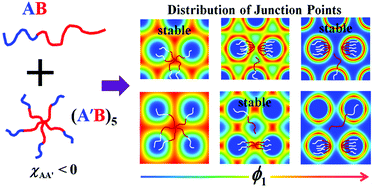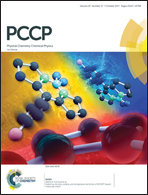Tetragonal phase of cylinders self-assembled from binary blends of AB diblock and (A′B)n star copolymers
Abstract
The phase behavior of binary blends composed of AB diblock and (A′B)n star copolymers is studied using the polymeric self-consistent field theory, focusing on the formation and stability of the stable tetragonal phase of cylinders. In general, cylindrical domains self-assembled from AB-type block copolymers are packed into a hexagonal array, although a tetragonal array of cylinders could be more favourable for lithography applications in microelectronics. The polymer blends are designed such that there is an attractive interaction between the A and A′ blocks, which increases the compatibility between the two copolymers and thus suppresses the macroscopic phase separation of the blends. With an appropriate choice of system parameters, a considerable stability window for the targeted tetragonal phase is identified in the blends. Importantly, the transition mechanism between the hexagonal and tetragonal phases is elucidated by examining the distribution of the two types of copolymers in the unit cell of the structure. The results reveal that the short (A′B)n star copolymers are preferentially located in the bonding area connecting two neighboring domains in order to reduce extra stretching, whereas the long AB diblock copolymers are extended to further space of the unit cell.



 Please wait while we load your content...
Please wait while we load your content...